CEO Room Interior Design in Bangladesh
Blend luxury and functionality with Design 2morrow for your CEO room interior design. Our expertise and knowledge of trends will help make your CEO rooms look and function at the top of their game. When I first stepped into the CEO office of a startup I consulted for, I immediately felt the impact of purposeful interior design. The atmosphere exuded confidence and professionalism. An executive’s workspace must not only reflect their leadership style but also inspire creativity and productivity. The CEO room is often where critical decisions are made, and its design can significantly influence those moments.
Why Is Design 2morrow Best For CEO Room Interior Design?
Design 2morrow is the optimal choice for CEO room design due to our unwavering commitment to sophistication and functionality. We understand the distinct needs of executives and excel in creating spaces that harmonize luxury with practicality.
Our designs go beyond aesthetics, reflecting the high status of CEOs while fostering a productive work environment. With meticulous attention to detail, we ensure CEO rooms are visually stunning and conducive to focused decision-making. It is what makes us the best office interior design firm in Bangladesh.
What sets us apart is our ability to tailor each design to the unique preferences of the executive, creating a personalized space that resonates with their identity. By seamlessly blending comfort, style, and professional aesthetics, Design 2morrow redefines CEO rooms, making us the ideal choice for those seeking an elevated and inspiring workspace.
Services Included in Our CEO Room Design
As we are one of the best office interior design firms in Bangladesh, we take pride in providing our clients with top-of-the-line CEO room design services. Included in our services are:
- Space Planning: Expert organization and optimization of the CEO room layout for functionality and visual appeal.
- Premium Furniture Selection: Careful curation of high-quality, stylish furniture complements the executive's stature.
- Lighting Solutions: Planning lighting arrangements to enhance ambiance and create a well-lit executive space.
- Color Palette Customization: Select sophisticated color schemes that reflect professionalism and align with the executive's preferences.
- Personalization: Incorporation of personalized touches and branding elements to add a unique and distinguished character to the CEO room design.
Benefits of a Well-Designed CEO Room
A thoughtfully designed CEO room offers several benefits:
- Enhanced Productivity: Comfortable and functional spaces boost focus.
- Improved Mood: A visually appealing room can uplift spirits.
- Client Impressions: A sophisticated space elevates the perception of professionalism.
Factors Influencing CEO Room Interior Design
When considering the design of a CEO room, several factors come into play:
Functionality: The layout must accommodate meetings, calls, and personal work.
By making these considerations, we can create an executive workspace that truly enhances effectiveness and image.
Company Culture: The design should align with the brand’s identity.
Trends and Technology: Incorporating modern aesthetics and tech solutions is crucial.

Benefits of Getting the Best CEO Room Design
By working with Design 2morrow, you can be sure you will experience many benefits you won’t find anywhere else. Some of the benefits you can enjoy are:
- Enhanced Professional Image: A well-designed CEO room contributes to a positive company image, reinforcing professionalism.
- Optimized Functionality: CEO room designs prioritize functionality, ensuring a conducive environment for focused work and decision-making.
- Increased Productivity: Thoughtful designs inspire productivity, contributing to effective leadership and decision-making.
- Positive Executive Experience: A well-designed CEO room enhances the executive's overall work experience, promoting satisfaction and well-being.
- Customized Prestige: The best CEO room designs create a unique and prestigious space that aligns with the executive's status, fostering a sense of pride and ownership.
Design Elements and Layout Planning
Furniture Selection for CEO Room:
Transitioning from the initial importance of the CEO room, we move to its design elements. Selecting the right furniture is essential. I recall a project where we chose a sleek, ergonomic desk paired with a high-backed chair. Not only did it create a sense of authority, but it also ensured comfort during long work hours.
Desk: Should feature ample working space and storage.
Chair: Prioritize ergonomics to promote healthy posture.
Seating Area: Include a small sofa or chairs for informal meetings.
Lighting Solutions for a Productive Environment
Next, lighting plays a vital role in setting the room’s mood. I had a client who installed adjustable LED lights, allowing for a bright, invigorating atmosphere during the day and softer hues for evening tasks.
Natural Light: Whenever possible, maximize windows.
Accent Lighting: Use floor lamps and desk lights for warmth and focus.

Color Schemes and Textures
The color palette can evoke specific emotions. For instance, I once worked on a space using calming blues and rich woods, which facilitated focus and warmth.
- Color Choices: Choose colors that reflect company culture and inspire motivation.
- Textures: Combine materials like leather, wood, and fabric to add depth.
By carefully considering these elements, we can create a CEO room that functions effectively while also making a striking impression.
Personalization and Branding
Incorporating Personal Touches
After establishing the key design elements in the CEO room, let’s discuss how we can add unique personalization. I once assisted a CEO who proudly displayed a collection of vintage globes, a testament to their passion for travel. This not only sparked conversations but also created an inviting ambiance.
- Artwork: Feature local artists or personal favorites.
- Awards and Achievements: Showcase recognitions to inspire pride.
- Personal Mementos: Incorporate items with sentimental value.
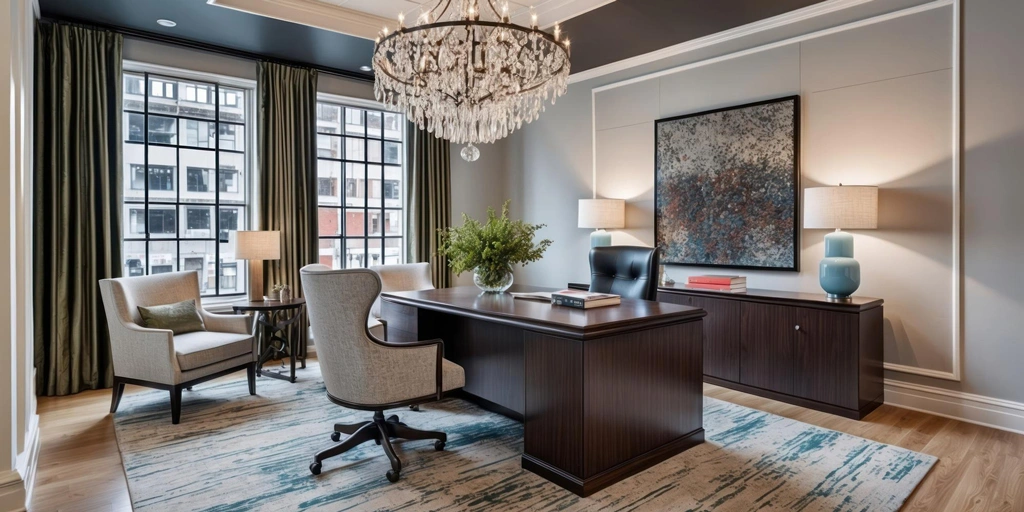
Reflecting Company Identity:
It’s equally important for the space to reflect the company’s identity. I worked with a tech firm that branded their office with innovative designs—think sleek lines and futuristic pieces that echoed their cutting-edge services.
- Logo Display: Use branding elements subtly, like in wall art or colors.
- Design Cohesion: Ensure that the decor aligns with corporate messaging.
Balancing Professionalism with Personality
Finally, striking the right balance is essential. A room should exude professionalism while also allowing for personal expression. For example, while a well-tailored suit is appropriate for meetings, a cozy reading nook can add a touch of comfort.
- Select Professional Pieces: Choose elegant furniture.
- Add Personality: Integrate comfortable elements to create warmth.
By blending these aspects, we create a CEO room that is not only functional but also inspires authenticity and connection.
Technology Integration and Functional Features
Smart Technology in CEO Offices:
Moving into the realm of technology, integrating smart solutions can greatly enhance the functionality of a CEO office. In a project I managed, we installed a smart assistant that controlled lighting, temperature, and even scheduled meetings with voice commands.
- Automated Systems: Install smart blinds and thermostats.
- Screen Sharing: Utilize wireless presentation tools for seamless meetings.
- Video Conferencing Solutions: Equip rooms with high-quality cameras and microphones for virtual meetings.
Ergonomic Considerations
Equally important are ergonomic considerations. I recall consulting with a CEO who frequently experienced back pain due to improper seating. We opted for a standing desk and adjustable chair that significantly improved their comfort during long hours.
- Adjustable Furniture: Invest in sit-stand desks.
- Supportive Seating: Prioritize chairs with lumbar support.
- Keyboard and Monitor Position: Ensure they are at eye level to avoid strain.
Storage and Organization Solutions
Lastly, efficient storage and organization are key features. In one office I designed, we incorporated built-in cabinetry that minimized clutter while providing easy access to important documents.
- Modular Storage: Use shelves and cabinets that can be reconfigured as needed.
- Paper Management: Implement filing systems to keep documents organized.
- Technology Docking Stations: Create dedicated spaces for charging devices and laptops.
By thoughtfully integrating these features, we can transform a CEO office into a highly functional and invigorating workspace that embraces modern demands.
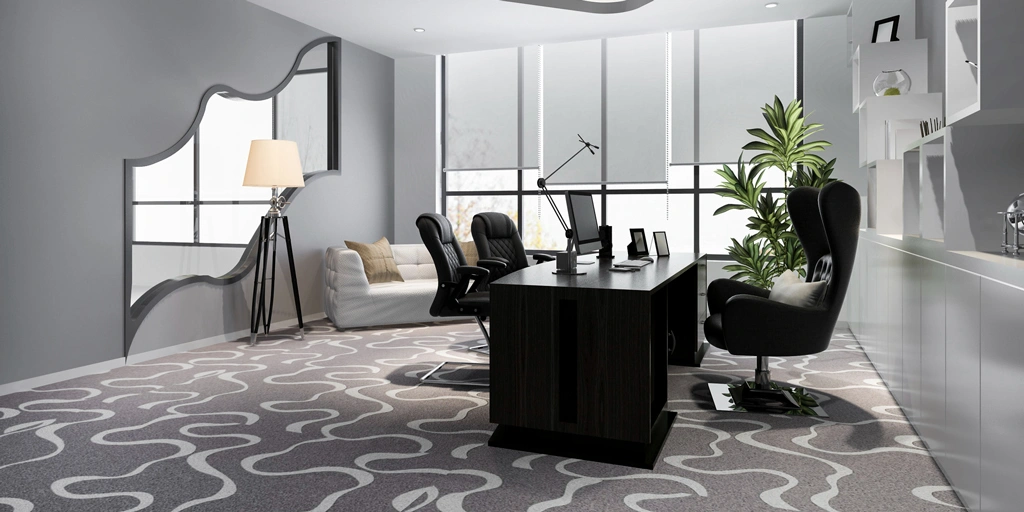
Green Design Approaches
As we transition to discussing sustainability, it’s important to incorporate eco-friendly practices into CEO room designs. I once worked on a project where we maximized natural light with strategically placed windows and skylights. This not only reduced energy consumption but also made the space feel expansive and open.
Biophilic Design: Incorporate plants and green walls for improved air quality.
Natural Lighting: Use light-colored surfaces to reflect sunlight.
Energy-Efficient Solutions
In pursuing energy efficiency, implementing smart technology can play a significant role. For example, in a recent redesign, we installed motion-sensor lights that automatically turned off when the room was vacant, dramatically reducing energy usage.
LED Lighting: Switch to energy-efficient bulbs that last longer.
Smart Thermostats: They optimize heating and cooling based on occupancy.
Sustainable Material Choices
Finally, selecting sustainable materials is crucial. During a renovation, I sourced reclaimed wood for furniture, which not only added character but also minimized environmental impact.
Recycled Materials: Choose furnishings made from recycled products.
Low-VOC Paints: Opt for paints with minimal volatile organic compounds for healthier air.
By embracing these sustainability principles, we not only contribute to environmental health but also create inspiring and conscientious executive spaces.
Budgeting and Project Management:
Setting a Budget for CEO Room Design:
Now that we’ve explored sustainability, let’s delve into budgeting and project management for the CEO room design. I often advise clients to establish a clear budget early on to guide decision-making. In one instance, a client tried to minimize costs without compromising quality, which resulted in unexpected delays.
Prioritize Needs: Determine essential elements such as furniture and technology.
Allocate Contingency Funds: Set aside 10-15% for unexpected expenses.
Working with Design Professionals:
Collaborating with design professionals can streamline the process. I once worked with an interior designer who specialized in executive spaces, ensuring every detail matched the client’s vision.
Choose the Right Designer: Ensure they have experience with executive room projects.
Regular Communication: Maintain open lines to address concerns promptly.
Timelines and Execution Strategies:
Lastly, having a well-defined timeline keeps the project on track. I recommend using project management tools to outline milestones and due dates.
Set Realistic Deadlines: Take into account potential delays and sourcing times.
Review Regularly: Hold periodic check-ins to assess progress.
By effectively managing budgets and timelines, we can create a stunning and functional CEO room within the desired parameters.
Office Interior Design Gallery

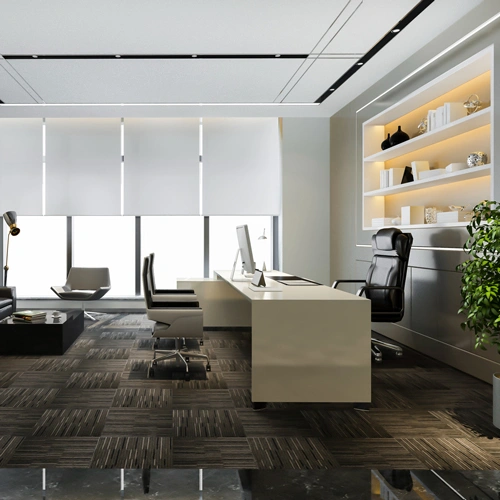
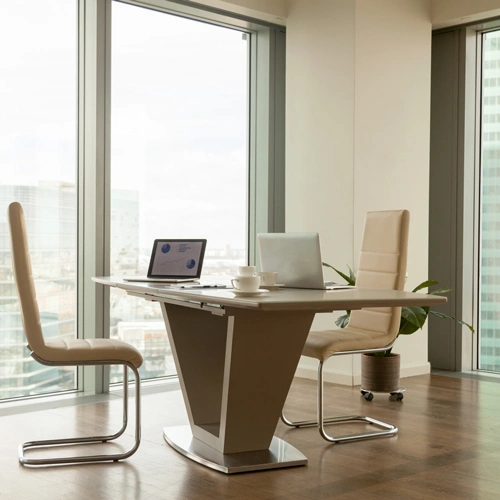
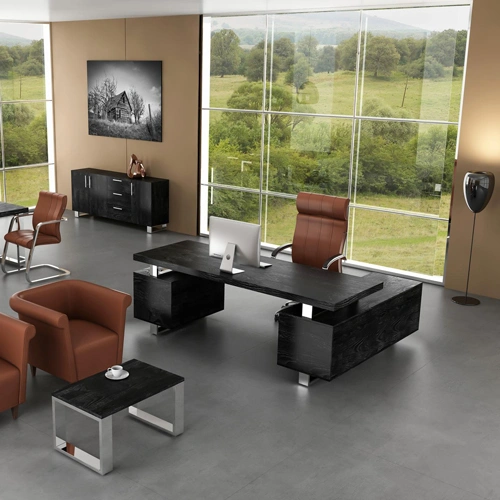

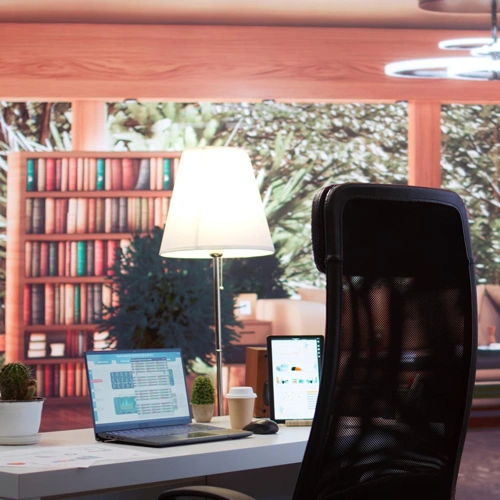
FAQ about CEO Room Interior Design:
-
What is Home Interior Design?Home interior design is the art and science of enhancing the interiors of a space to achieve a healthier and more aesthetically pleasing environment. This involves the use of color, furniture, decor, and layout to create a functional and beautiful living space.
-
Why is Interior Design Important?Interior design is crucial because it:
• Enhances Functionality: Properly designed spaces can improve the flow and usability of a home.
• Creates Atmosphere: Color schemes and décor can affect mood, making a home feel warm and inviting.
• Increases Value: A well-designed home can increase property value, attracting potential buyers. -
How Do I Begin My Interior Design Project?To kick off your interior design project, follow these steps:
1. Define Your Style: Research different styles (modern, rustic, bohemian, etc.) to find what resonates with you.
2. Set a Budget: Determine how much you can realistically spend on your project.
3. Create a Mood Board: Gather images, fabrics, and colors to visualize your desired look.
4. Plan Your Space: Measure your rooms to ensure furniture fits well and layout maximizes space.
-
Should I Hire a Professional Interior Designer?Hiring a professional can offer several benefits, such as:
• Expert Knowledge: Designers have experience and can help avoid costly mistakes.
• Access to Resources: Professionals often have access to unique furnishings and materials.
• Time-Saving: They can manage a project from start to finish, allowing you to focus on other things. -
How Can I Make My Small Space Feel Larger?To make a small space feel more spacious, try these tips:
• Use Light Colors: Soft, light colors can create an illusion of openness.
• Incorporate Mirrors: Mirrors can reflect light and make a space feel more expansive.
• Choose Multi-functional Furniture: Items like ottomans with storage help maximize utility.
• Keep It Clutter-Free: A tidy space always feels larger and more inviting. -
Can I Design My Home on a Budget?Absolutely! Interior design on a budget is achievable through:
• D.I.Y Projects: Get creative with do-it-yourself repairs and décor.
• Thrifting: Second-hand stores often have unique finds at a fraction of retail prices.
• Repurposing: Use what you already have in new and creative ways.
Best Interior Design Company in Bangladesh | Design 2morrow
Typically replies within minutes
আসসালামু আলাইকুম,
আপনার প্রয়োজণীয় তথ্য জানার জন্য ফোন করুন,
☎️ +8801870720555, অথবা- ভিজিট করুন আমাদের ওয়েবসাইট-
🌍 www.design2morrow.com
ধন্যবাদ
Design 2morrow | Interior Design Company
CEO Room Interior Design?
WhatsApp Us
🟢 Online | Privacy policy
WhatsApp us
